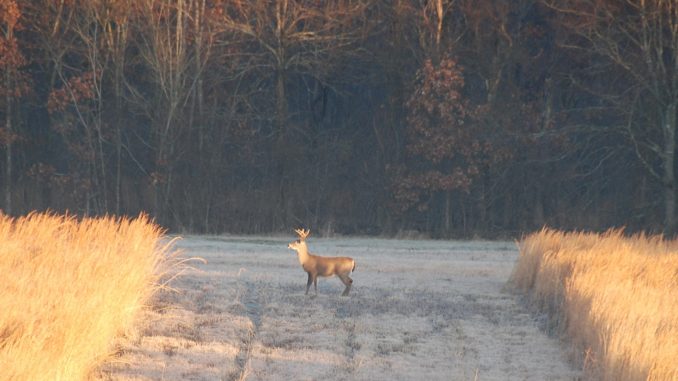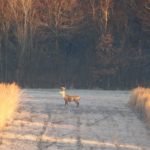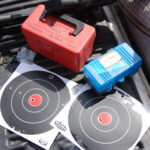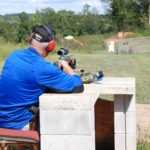
When shooting at a deer across a beanfield or down a power line, make sure your equipment is up to the task and you’ve had plenty of practice, practice, practice.
Jerry Land of Greer grew up hunting in rural Pennsylvania where he had few opportunities to take shots at whitetail deer at distances greater than 100 yards. After a career in the U.S. Air Force, while working with the U.S. Department of Interior in South Dakota, he discovered prairie dogs. That led to a passion for long-range, precision shooting, and he eventually collected five national titles for bench-rest varmint shooting.
In applying long-range shooting skills to deer, the question arises: How far is too far to take an ethical shot on a big game animal? It’s like asking how fast is too fast to drive a racecar on an open road with no speed limit. The answer boils down to what kind of car are you driving and how good are you at driving it. Some hunters might limit themselves to 200 or 250 yards; some might stretch things out another football field in length.
Equipment is the first key. Achieving 200 miles per hour simply isn’t going to happen in a Ford Pinto, and that’s just as unlikely as a deer hunter routinely making 400-yard shots with an entry level production gun, economy scope and clearance-sale ammunition.
“The scope is more important than the gun,” said Land. “Accuracy is achieved by doing the same, exact thing, over and over, and if a scope will not hold true, it’s impossible to be accurate.”
He suggests applying a box test to a new scope, starting at center, clicking the elevation 40 clicks up and the vertical 40 clicks right and fire a shot while aiming at the center. Next pull the crosshairs 40 clicks down and fire, 40 clicks left and so on. The pattern should begin chipping away a perfect square on paper.
Ammunition is next. Books have been written about ballistic accuracy using a variety of calibers, bullet weights, and powder loads. Land became a hand-loader by necessity while shooting competitively. Most of his competition guns, all custom made, do not shoot common factory calibers and loads. He said this about finding the right bullets for hunting deer at longer range.
“Short of hand-loading, which allows you to more precisely align the bullet in the casing, which in turn keeps the bullets from bouncing off the sides of the barrel as it exits, my advice is to spend time searching for the factory load that best fits your gun,” he said. “Premium ammo costs more for a reason. The tolerances, which you can measure on a concentricity gauge with a .001 dial indicator, are much tighter and thus more accurate downrange at longer distances.”
Just like the directions for getting to Carnegie Hall, the only way to be a better long distance shot is to practice, practice, practice. Land suggests having a goal in mind, wanting to accomplish something every time you pull the trigger.
“I suggest having an objective in mind when you practice,” he said. “You want to touch the gun the same way every time you shoot. That builds consistency and accuracy. Also, practice at distances you want to be able to shoot. If it’s 400 yards, there are a lot of variables that affect accuracy. The slightest vibration or movement that causes you to miss one-half inch at 50 yards will move the bullet dramatically out at 400 yards.”
Other factors that increase a shooters skill level are learning how wind drift affects your shots and practicing with wind indicators in place to help compensate for wind drift. The same could be said for distance estimation and working how much the particular bullet will drop downrange and working that into your practice sessions.
Land suggests other skill-level practices such as dry-firing centerfire guns at a target while watching through the scope. Work to decrease movement of the crosshairs when the trigger is pulled. Having another shooter video tape your performance will let you see what parts of your technique you need to improve.
“Compare practices by shot placement, working to move all of your shots into a tighter group,” he said.
While all of the various aspects work together, possibly the most basic is shooting off of a stable rest. In his bench-rest shooting competitions, having a stable rest was not even an afterthought, but taking a long-distance shot at an animal from a hunting stand is much different.
“In a deer-hunting situation, that’s a variable only the hunter can account for,” said Land. “It’s impractical to think making long distance shots is possible offhand. The gun needs to be stationary and that means holding it steady, on some type of support to immobilize the gun.”
For most hunters, that could mean a padded rest, either the lower part of a window seal in a box blind or a sand bag on the rim of a steady tree stand.
In addition, the most-accurate gun in South Carolina may not be on target if the hunter cannot accurately estimate the range at which a deer is standing. Having a rangefinder on hand or having ranged various geographic or physical features around a field or along a power line — a certain tree, a fence, a stump — will certainly help a hunter know it’s 300 yards when he estimates that it’s 300 yards.







Be the first to comment